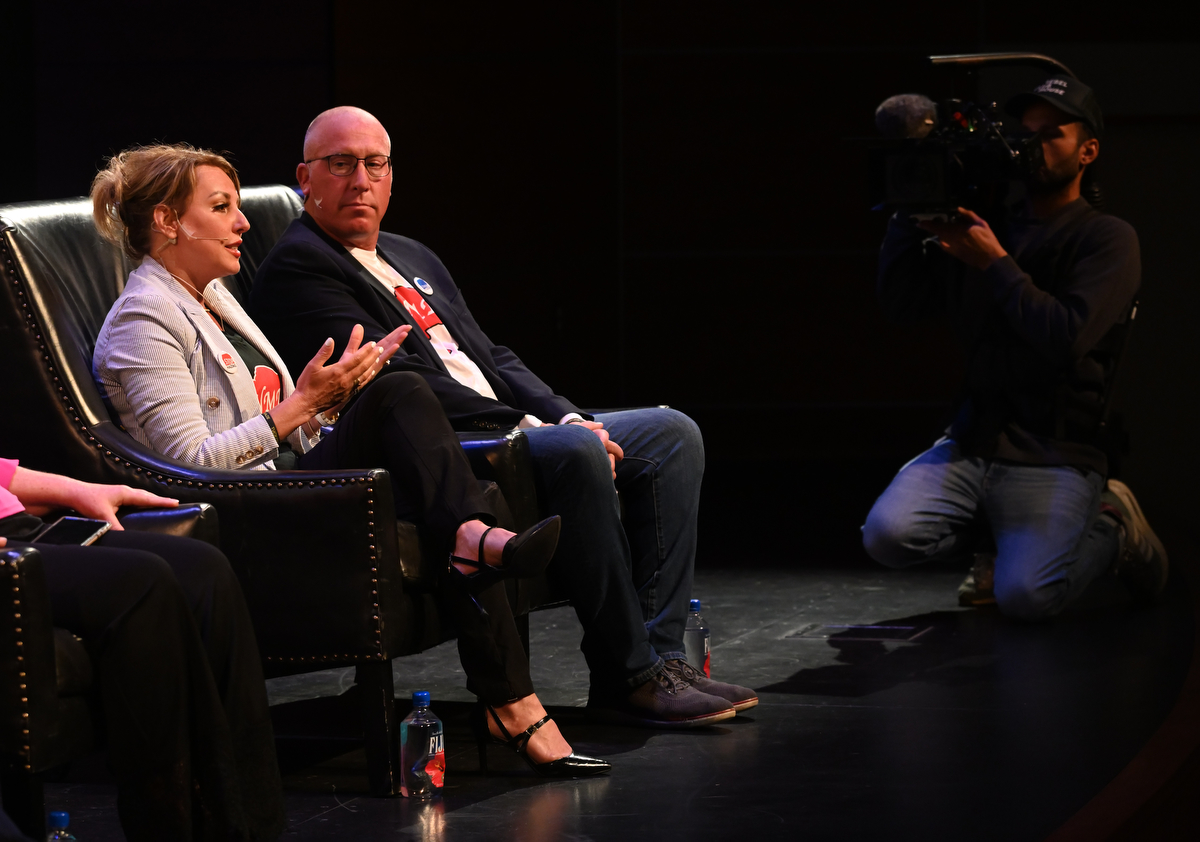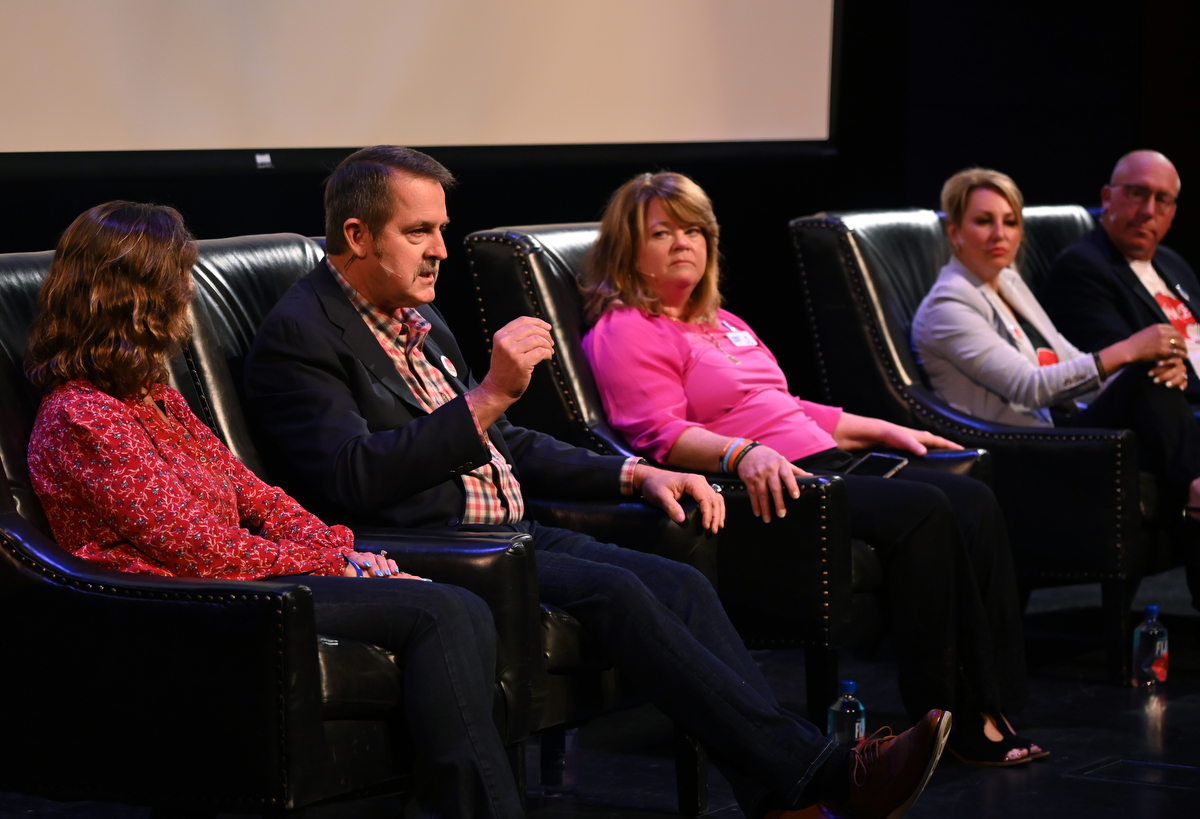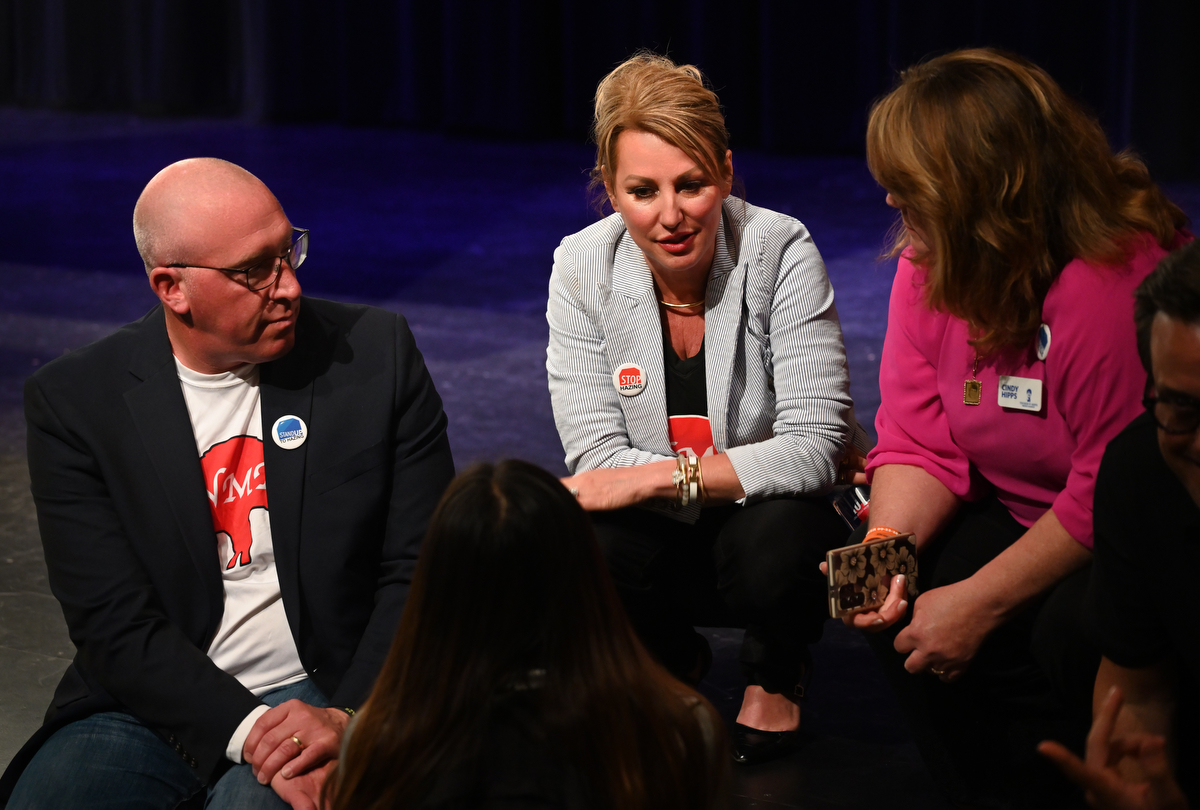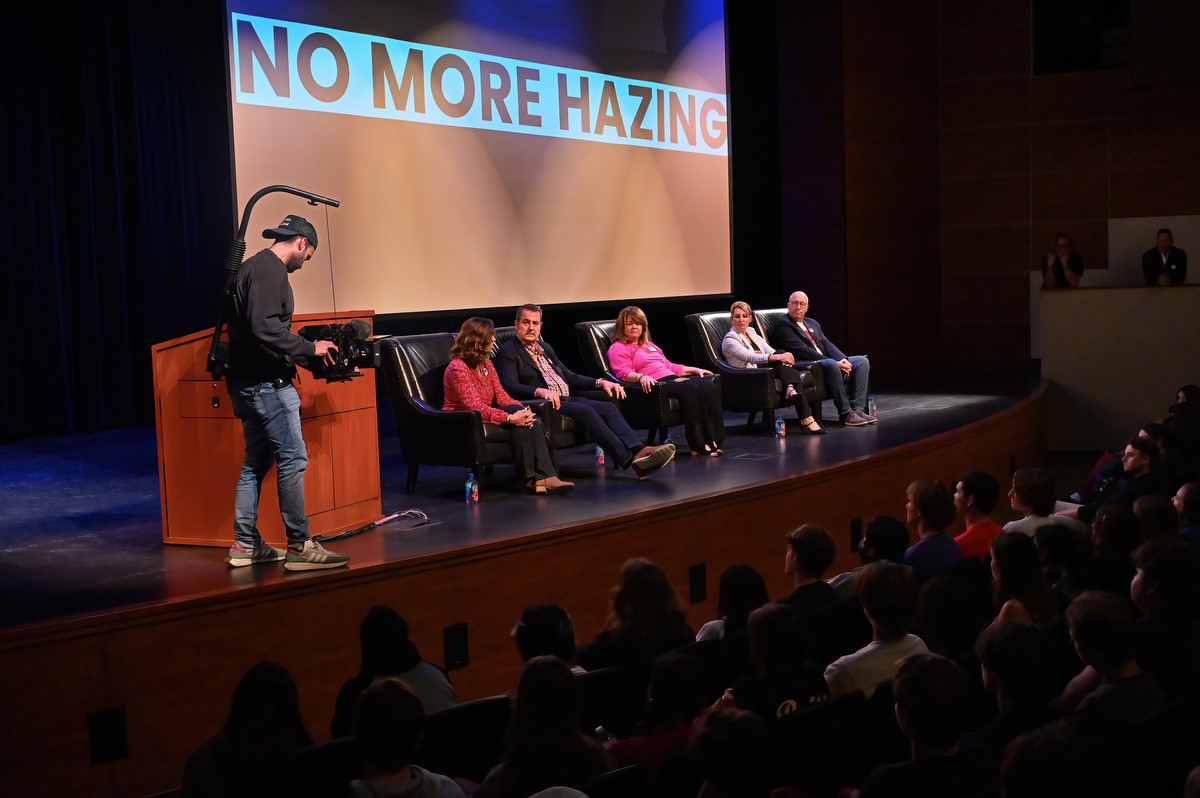By Greg Mellen
On a warm May day Capistrano Valley High was festooned in school colors as students prepared to celebrate its seniors with an afternoon college assembly and rally.
However, before the festivities began, an event just for seniors was held with a sobering message.
In the packed out auditorium, students gathered to learn about the dangerous, and occasionally fatal, consequences of hazing, particularly in college fraternities and groups.
In conjunction with the Capistrano Unified School District and the City of Mission Viejo, local filmmaker Dan Catullo of Coto de Caza, showed an extended trailer of his upcoming documentary film “Protect The House,” detailing the stories of college freshmen, who died while pledging with fraternities, followed by a question-and-answer session with the parents of three of the victims.
“I didn’t want to spoil their event,” Catullo said of the impending graduation rally and surrounding activities. “But it’s important to hit them in the gut so they go (on to college with) eyes wide open. It’s crazy out there right now.”
In addition to the session at Capistrano Valley High, another was held at Tesoro High and a community meeting was staged in Mission Viejo for families with children about to go to college.
Catullo said that by revealing the often hidden world of hazing he hoped, “Mission Viejo kids will go out and be an example.”
According to StopHazing.org, 44 states have enacted laws against the practice. And yet it endures. A long-running effort to create federal legislation is ongoing.
At the filming, dozens of students raised their hands when asked if they were aware of hazing in high school.
“This is something that is heavy,” Catullo said. “Even if you see it in high school, it’s a lot crazier in college.”

Photo by Steven Georges/CUSD Insider
Stunned silence
Although the high school students arrived in high spirits, several hooting and clapping when the film started, when the clip ended and the lights came up, the room was utterly silent.
“You can always tell,” T.J. Burch said of when the film hits home.
Burch’s son, Nolan was one of the featured victims in the film.
Every year college students undergo hazing, sometimes intense, as they attempt to join various clubs, secret societies, teams, and fraternities. And each year, somewhere it goes awry. Although death and serious injuries are rare, 82 percent of reported deaths are alcohol related. Sexual assault, intimidation, physical harm, and shaming occur and can still bring about long lasting psychological damage.
No formal national database is kept on injuries and deaths as a result of the practices, although it is generally expected the numbers are significantly under-counted. This is due, in part, to the secrecy many pledge to their groups. Often it is just chalked to binge drinking, which kills about 2,000 college students annually, according to alcoholrehabguide.org, without being linked to a group.
The full documentary, “Protect the House,” is expected in 2024. It builds off Catullo’s Emmy-winning documentary “Breathe, Nolan, Breathe,” about the death of Burch at West Virginia University from acute alcohol poisoning.
“I’ve watched half the kids around here grow up,” said Catullo, an alumnus of WVU, whose daughter attends Santa Margarita High. “I thought, ‘Let’s rally Mission Viejo and train the kids. I wanted to give back to the community.”
On hand afterward for a question and answer session were the parents of several hazing victims: T.J. and Kim Burch, parents of son Nolan, who died in West Virginia; Cindy Hipps, mom of Tucker Hipps, who died at Clemson University; and Julie and Gary DeVercelly Sr. of Long Beach, whose son, Gary Jr., died as a freshman at Rider University in New Jersey.
The Burches traveled from their home in Buffalo, N.Y., and Hipps came from South Carolina to participate.
Seated on the auditorium stage in five chairs arrayed in front of the projection screen, they answered questions for about half an hour.

Photo by Steven Georges/CUSD Insider
Lives cut short
The extended trailer told stories of students at West Virginia University, Rider, Cornell, University, LSU, Penn St., and Clemson where tragedy struck.
The three boys whose parents were at the screening were popular freshmen. Burch was a happy-go-lucky kid, quick to volunteer to help others, Hipps was president of his pledge class, and DeVercelly had been recruited by several fraternities.
Burch and Hipps died in 2014 and DeVercelly in 2007. Burch and DeVercelly died after excessive alcohol consumption as part of their initiation. Hipps drowned in a lake near campus after falling from a bridge under mysterious circumstances.
Burch’s death gained added attention because of Catullo’s film and troubling video from the fraternity house. It shows an upperclassman, who had not been involved in the rituals, frantically trying to revive the 18-year-old student.
The film opens on a black screen with just voices.
“One, two, three, Nolan, breathe for me buddy,” the student exhorts, while performing CPR on Burch’s prone body.
Earlier the boy had been dragged unconscious into the frat house and dropped on a small elevated platform and lightly kicked in the ribs.
Burch had been made to consume a bottle of alcohol at part of his fraternity initiation ritual
Hipps went missing early in the morning, although it was not reported for hours.

Photo by Steven Georges/CUSD Insider
It was believed he was made to run on the railing of a bridge as a punishment for failing to deliver biscuits, hash browns, and milk to a fraternity breakfast. It took more than 8 hours before authorities were led to the lake where the body was found.
Despite a six-figure reward, no one has come forward to explain what happened.
DeVercelly, nicknamed “Cali” for his home state, had not intended to join a fraternity when he entered school, but was later persuaded to join. He died after consuming most of a 25-ounce bottle of vodka during an initiation party.
When DeVercelly became sick, rather than call police, fraternity members took the 18-year-old to his room to sleep it off.
“We’re talking to you about being better than that,” Gary DeVercelly, Sr. said.
In all three cases, despite investigations, no one was ever sentenced to jail time, although the three families won civil suits. All three families subsequently formed nonprofits in their sons’ memories.
Julie DeVercelly said rather than sue for a large cash settlement, she and her husband made 20 non-monetary demands and worked with Rider to enact fraternity reforms on campus.
“The culture needs to change,” she said, adding that although she supports the team building and unity fraternities espouse, those are currently attempted “in a negative way.”
After the Q/A, about a half-dozen students went down to spend time with the parents, to thank them and ask questions.
Tristan Nelissen, 18, a senior, wants to be a firefighter. He was particularly affected by the segment in the film, captured on security camera inside the Kappa Sigma house, when the frat brother feverishly worked on the body of Nolan Burch.
“I want to be like that guy,” he said.
Nelissen said he was inspired by the film to be proactive should he encounter hazing, and would not stonewall investigators and families of victims.
“I’d always tell the truth,” he said.

Photo by Steven Georges/CUSD Insider
Problem lingers
Despite efforts like those in Mission Viejo and similar outreach, hazing continues and is resistant to change.
The proposed Federal Report and Educate About Campus Hazing Act, or the REACH Act, was introduced in July 2017, then reintroduced in 2019 and 2021. It will be reintroduced this year under the 118th Congress as the Stop Campus Hazing Act. The bipartisan, bicameral bill will amend the Clery Act and require hazing to be included in higher education institutions Annual Security Reports (ASR) and provide hazing awareness, research supported education and prevention policies.
In California, Matt’s Law, passed in 2006, calls for felony prosecutions for death or serious injury from hazing incidents. That law came about in the wake of the death of Matt Carrington at Chico State in 2005 by water poisoning from a ritual in which he had to drink excessive amounts of water while performing calisthenics.
As recently at May 11, this year, UCLA announced it was closing Bruin Woods summer camp in the wake of allegations of hazing traditions and sexual assault from students who worked at the Lake Arrowhead getaway.
In April the family of former San Diego State University student Benjamin Brennan brought a suit against a fraternity after a hazing incident involving excessive alcohol left the 19-year-old in a temporary coma and “almost killed him.”
For all the efforts and media attention, the kids-will-be-kids attitude remains pervasive, and it goes down to the vocabulary. It is often referred to as “pranks” or “initiation.”

Photo by Steven Georges/CUSD Insider
According to StopHazing, a University of Maine nonprofit, although more than half of student’s report being involved in some kind of campus hazing, 95 percent do not report it.
In sports, it is even more prevalent than fraternities and sororities. More than 250,000 students experienced some sort of hazing to join a college athletic team. Half the females NCAA Division I athletes reported being hazed, including 20 percent subjected to alcohol-related incidents, as well as mental and physical hazing, which ranged from tattooing to branding to being kidnapped.
According to organizers of the Mission Viejo event, “Hazing is really prevalent. We think there are dozens more deaths (than reported).”
And for the families of those who die, the pain lingers.
Gary DeVercelly said his heart goes out particularly to those like Cindy Hipps, whose only child was Tucker.
The father of a younger son and daughter, DeVercelly says, “I tell my children they saved me.”

Photo by Steven Georges/CUSD Insider

Photo by Steven Georges/CUSD Insider

